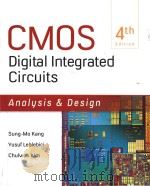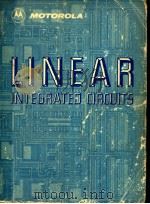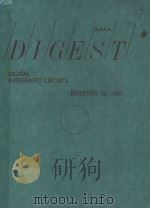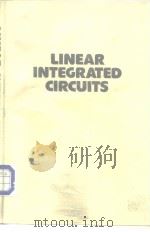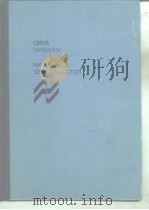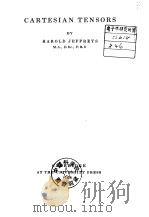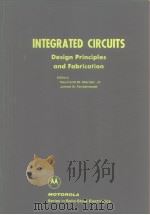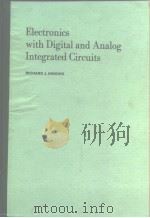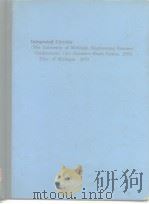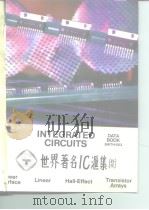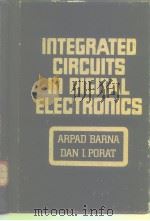《DIGITAL INTEGRATED CIRCUITS》
| 作者 | 编者 |
|---|---|
| 出版 | 未查询到或未知 |
| 参考页数 | 763 |
| 出版时间 | 没有确切时间的资料 目录预览 |
| ISBN号 | 无 — 求助条款 |
| PDF编号 | 819664608(仅供预览,未存储实际文件) |
| 求助格式 | 扫描PDF(若分多册发行,每次仅能受理1册) |
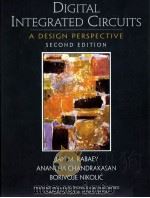
Part 1The Fabrics1
Chapter 1Introduction3
1.1 A Historical Perspective4
1.2 Issues in Digital Integrated Circuit Design6
1.3Quality Metrics of a Digital Design15
1.3.1 Cost of an Integrated Circuit16
1.3.2 Functionality and Robustness18
1.3.3 Performance27
1.3.4 Power and Energy Consumption30
1.4 Summary31
1.5To Probe Further31
Reference Books32
References33
Chapter 2The Manufacturing Process35
2.1 Introduction36
2.2Manufacturing CMOS Integrated Circuits36
2.2.1 The Silicon Wafer37
2.2.2 Photolithography37
2.2.3 Some Recurring Process Steps41
2.2.4 Simplified CMOS Process Flow42
2.3 Design Rules—The Contract between Designer and Process Engineer47
2.4Packaging Integrated Circuits51
2.4.1 Package Materials52
2.4.2 Interconnect Levels53
2.4.3 Thermal Considerations in Packaging59
2.5Perspective—Trends in Process Technology61
2.5.1 Short-Term Developments61
2.5.2 In the Longer Term63
2.6 Summary64
2.7To Probe Further64
References64
Design Methodology Insert AIC LAYOUT67
A.1To Probe Further71
References71
Chapter 3The Devices73
3.1 Introduction74
3.2The Diode74
3.2.1 A First Glance at the Diode—The Depletion Region75
3.2.2 Static Behavior77
3.2.3 Dynamic,or Transient,Behavior80
3.2.4 The Actual Diode—Secondary Effects84
3.2.5 The SPICE Diode Model85
3.3The MOS(FET) Transistor87
3.3.1 A First Glance at the Device87
3.3.2 The MOS Transistor under Static Conditions88
3.3.3 The Actual MOS Transistor—Some Secondary Effects114
3.3.4 SPICE Models for the MOS Transistor117
3.4 A Word on Process Variations120
3.5 Perspective—Technology Scaling122
3.6 Summary128
3.7To Probe Further129
References130
Design Methodology Insert BCircuit Simulation131
References134
Chapter 4The Wire135
4.1 Introduction136
4.2 A First Glance136
4.3Interconnect Parameters—Capacitance,Resistance,and Inductance138
4.3.1 Capacitance138
4.3.2 Resistance144
4.3.3 Inductance148
4.4Electrical Wire Models150
4.4.1 The Ideal wire151
4.4.2 The Lumped Model151
4.4.3 The Lumped RC Model152
4.4.4 The Distributed rc Line156
4.4.5 The Transmission Line159
4.5SPICE Wire Models170
4.5.1 Distributed rc Lines in SPICE170
4.5.2 Transmission Line Models in SPICE170
4.5.3 Perspective:A Look into the Future171
4.6Summary174
4.7To Probe Further174
References174
Part 2A Circuit Perspective177
Chapter 5The CMOS Inverter179
5.1 Introduction180
5.2 The Static CMOS Inverter—An Intuitive Perspective180
5.3Evaluating the Robustness of the CMOS Inverter:The Static Behavior184
5.3.1 Switching Threshold185
5.3.2 Noise Margins188
5.3.3 Robustness Revisited191
5.4Performance of CMOS Inverter:The Dynamic Behavior193
5.4.1 Computing the Capacitances194
5.4.2 Propagation Delay:First-Order Analysis199
5.4.3 Propagation Delay from a Design Perspective203
5.5Power,Energy,and Energy Delay213
5.5.1 Dynamic Power Consumption214
5.5.2 Static Consumption223
5.5.3 Putting It All Together225
5.5.4 Analyzing Power Consumption Using SPICE227
5.6 Perspective:Technology Scaling and its Impact on the Inverter Metrics229
5.7 Summary232
5.8To Probe Further233
References233
Chapter 6Designing Combinational Logic Gates in CMOS235
6.1 Introduction236
6.2Static CMOS Design236
6.2.1 Complementary CMOS237
6.2.2 Ratioed Logic263
6.2.3 Pass-Transistor Logic269
6.3Dynamic CMOS Design284
6.3.1 Dynamic Logic:Basic Principles284
6.3.2 Speed and Power Dissipation of Dynamic Logic287
6.3.3 Signal Integrity Issues in Dynamic Design290
6.3.4 Cascading Dynamic Gates295
6.4Perspectives303
6.4.1 How to Choose a Logic Style?303
6.4.2 Designing Logic for Reduced Supply Voltages303
6.5 Summary306
6.6To Probe Further307
References308
Design Methodology Insert CHow to Simulate Complex Logic Circuits309
C.1 Representing Digital Data as a Continuous Entity310
C.2 Representing Data as a Discrete Entity310
C.3Using Higher-Level Data Models315
References317
Design Methodology Insert D Layout Techniques for Complex Gates319
Chapter 7Designing Sequential Logic Circuits325
7.1Introduction326
7.1.1 Timing Metrics for Sequential Circuits327
7.1.2 Classification of Memory Elements328
7.2Static Latches and Registers330
7.2.1 The Bistability Principle330
7.2.2 Multiplexer-Based Latches332
7.2.3 Master-Slave Edge-Triggered Register333
7.2.4 Low-Voltage Static Latches339
7.2.5 Static SR Flip-Flops—Writing Data by Pure Force341
7.3Dynamic Latches and Registers344
7.3.1 Dynamic Transmission-Gate Edge-triggered Registers344
7.3.2 C 2MOS—A Clock-Skew Insensitive Approach346
7.3.3 True Single-Phase Clocked Register (TSPCR)350
7.4Alternative Register Styles354
7.4.1 Pulse Registers354
7.4.2 Sense-Amplifier-Based Registers356
7.5Pipelining:An Approach to Optimize Sequential Circuits358
7.5.1 Latch- versus Register-Based Pipelines360
7.5.2 NORA-CMOS—A Logic Style for Pipelined Structures361
7.6Nonbistable Sequential Circuits364
7.6.1 The Schmitt Trigger364
7.6.2 Monostable Sequential Circuits367
7.6.3 Astable Circuits368
7.7 Perspective:Choosing a Clocking Strategy370
7.8 Summary371
7.9To Probe Further372
References372
Part 3A System Perspective375
Chapter 8Implementation Strategies for Digital ICS377
8.1 Introduction378
8.2 From Custom to Semicustom and Structured-Array Design Approaches382
8.3 Custom Circuit Design383
8.4Cell-Based Design Methodology384
8.4.1 Standard Cell385
8.4.2 Compiled Cells390
8.4.3 Macrocells,Megacells and Intellectual Property392
8.4.4 Semicustom Design Flow396
8.5Array-Based Implementation Approaches399
8.5.1 Prediffused (or Mask-Programmable) Arrays399
8.5.2 Prewired Arrays404
8.6 Perspective—The Implementation Platform of the Future420
8.7 Summary423
8.8To Probe Further423
References424
Design Methodology Insert ECharacterizing Logic and Sequential Cells427
References434
Design Methodology Insert FDesign Synthesis435
References443
Chapter 9Coping with Interconnect445
9.1 Introduction446
9.2Capacitive Parasitics446
9.2.1 Capacitance and Reliability—Cross Talk446
9.2.2 Capacitance and Performance in CMOS449
9.3Resistive Parasitics460
9.3.1 Resistance and Reliability—Ohmic Voltage Drop460
9.3.2 Electromigration462
9.3.3 Resistance and Performance—RC Delay464
9.4Inductive Parasitics469
9.4.1 Inductance and Reliability— Voltage Drop469
9.4.2 Inductance and Performance—Transmission-line Effects475
9.5Advanced Interconnect Techniques480
9.5.1 Reduced-Swing Circuits480
9.5.2 Current-Mode Transmission Techniques486
9.6 Perspective:Networks-on-a-Chip487
9.7 Summary488
9.8To Probe Further489
References489
Chapter 10 Timing Issues in Digital Circuits491
10.1Introduction492
10.2Timing Classification of Digital Systems492
10.2.1 Synchronous Interconnect492
10.2.2 Mesochronous interconnect493
10.2.3 Plesiochronous interconnect493
10.2.4 Asynchronous Interconnect494
10.3Synchronous Design—An In-depth Perspective495
10.3.1 Synchronous Timing Basics495
10.3.2 Sources of Skew and Jitter502
10.3.3 Clock-Distribution Techniques508
10.3.4 Latch-Based Clocking516
10.4Self-Timed Circuit Design519
10.4.1 Self-Timed Logic—An Asynchronous Technique519
10.4.2 Completion-Signal Generation522
10.4.3 Self-Timed Signaling526
10.4.4 Practical Examples of Self-Timed Logic531
10.5Synchronizers and Arbiters534
10.5.1 Synchronizers—Concept and Implementation534
10.5.2 Arbiters538
10.6Clock Synthesis and Synchronization Using a Phase-Locked Loop539
10.6.1 Basic Concept540
10.6.2 Building Blocks of a PLL542
10.7Future Directions and Perspectives546
10.7.1 Distributed Clocking Using DLLs546
10.7.2 Optical Clock Distribution548
10.7.3 Synchronous versus Asynchronous Design549
10.8 Summary550
10.9To Probe Further551
References551
Design Methodology Insert GDesign Verification553
References557
Chapter 11 Designing Arithmetic Building Blocks559
11.1Introduction560
11.2 Datapaths in Digital Processor Architectures560
11.3The Adder561
11.3.1 The Binary Adder:Definitions561
11.3.2 The Full Adder:Circuit Design Considerations564
11.3.3 The Binary Adder:Logic Design Considerations571
11.4 The Multiplier586
11.4.1 The Multiplier:Definitions586
11.4.2 Partial-Product Generation587
11.4.3 Partial-Product Accumulation589
11.4.4 Final Addition593
11.4.5 Multiplier Summary594
11.5The Shifter594
11.5.1 Barrel Shifter595
11.5.2 Logarithmic Shifter596
11.6 Other Arithmetic Operators596
11.7Power and Speed Trade-offs in Datapath Structures600
11.7.1 Design Time Power-Reduction Techniques601
11.7.2 Run-Time Power Management611
11.7.3 Reducing the Power in Standby (or Sleep) Mode617
11.8 Perspective:Design as a Trade-off618
11.9 Summary619
11.10 To Probe Further620
References621
Chapter 12 Designing Memory and Array Structures623
12.1Introduction624
12.1.1 Memory Classification625
12.1.2 Memory Architectures and Building Blocks627
12.2The Memory Core634
12.2.1 Read-Only Memories634
12.2.2 Nonvolatile Read-Write Memories647
12.2.3 Read-Write Memories (RAM)657
12.2.4 Contents-Addressable or Associative Memory (CAM)670
12.3Memory Peripheral Circuitry672
12.3.1 The Address Decoders672
12.3.2 Sense Amplifiers679
12.3.3 Voltage References686
12.3.4 Drivers/Buffers689
12.3.5 Timing and Control689
12.4Memory Reliability and Yield693
12.4.1 Signal-to-Noise Ratio693
12.4.2 Memory Yield698
12.5Power Dissipation in Memories701
12.5.1 Sources of Power Dissipation in Memories701
12.5.2 Partitioning of the Memory702
12.5.3 Addressing the Active Power Dissipation702
12.5.4 Data-Retention Dissipation704
12.5.5 Summary707
12.6Case Studies in Memory Design707
12.6.1 The Programmable Logic Array (PLA)707
12.6.2 A 4-Mbit SRAM710
12.6.3 A 1-Gbit NAND Flash Memory712
12.7 Perspective:Semiconductor Memory Trends and Evolutions714
12.8 Summary716
12.9To Probe Further717
References718
Design Methodology Insert HValidation and Test of Manufactured Circuits721
H.1 Introduction721
H.2 Test Procedure722
H.3Design for Testability723
H.3.1 Issues in Design for Testability723
H.3.2 Ad Hoc Testing725
H.3.3 Scan-Based Test726
H.3.4 Boundary-Scan Design729
H.3.5 Built-in Self-Test (BIST)730
H.4Test-Pattern Generation734
H.4.1 Fault Models734
H.4.2 Automatic Test-Pattern Generation (ATPG)736
H.4.3 Fault Simulation737
H.5To Probe Further737
References737
Problem Solutions739
Index745
《DIGITAL INTEGRATED CIRCUITS》由于是年代较久的资料都绝版了,几乎不可能购买到实物。如果大家为了学习确实需要,可向博主求助其电子版PDF文件。对合法合规的求助,我会当即受理并将下载地址发送给你。
高度相关资料
-
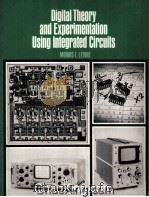
- Digital theory and experimentation using integrated circuits
- 1974 Prentice-Hall
-
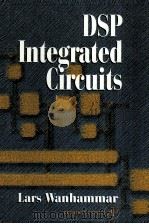
- DSP INTEGRATED CIRCUITS
- 1999 ACADEMIC PRESS
-
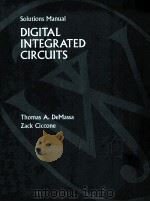
- SOLUTIONS MANUAL TO ACCOMPANY DIGITAL INTEGRATED CIRCUITS
- 1996 JOHN WILEY & SONS,INC.
提示:百度云已更名为百度网盘(百度盘),天翼云盘、微盘下载地址……暂未提供。➥ PDF文字可复制化或转WORD
